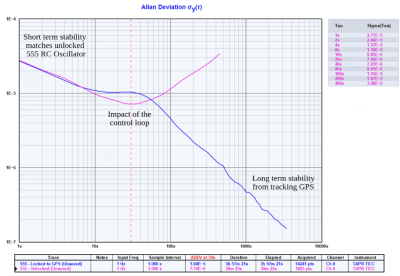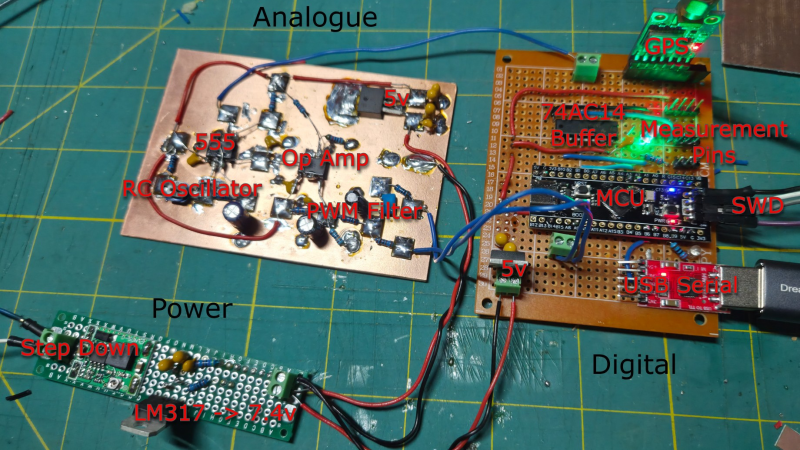One of the categories we chose for the One Hertz Challenge is “Could Have Used a 555.” What about when you couldn’t have, but did anyway? The 555 is famously easy to use, but not exactly the most accurate timer out there — one “ticking” at 1 Hz will pulse just about once per second (probably to within a millisecond, depending on the rest of the circuit), but when you need more precise timing, the 555 just won’t cut it. Not on its own, anyway.

This entry by [burble] shows us how the humble 555 can hold its own in more demanding systems with some help from a GPS receiver. He used the One Pulse per Second (1PPS) output from a GPS module to discipline the 1 Hz output from a 555 by modulating the control voltage with a microcontroller.
Okay, this sounds a bit like baking a cake by buying a cake, scraping all the icing off, then icing it yourself, but what better way to learn how to ice a cake? The GPS-disciplined 555 is way more accurate than a free running one — just check out that Allan Deviation plot. While the accuracy of the standard 555 begins to decrease as oscillator drift dominates, the GPS-disciplined version just keeps getting better (up to a point — it would also eventually begin to increase, if the data were recorded for long enough). Compared to other high-end oscillators though, [burble] describes the project’s accuracy in one word: “Badly.”
That’s okay though — it really is a fantastic investigation into how GPS-disciplined oscillators work, and does a fantastic job illustrating the accuracy of different types of clocks, and some possible sources of error. This project is a great addition to some of the other precision timekeeping projects we’ve seen here at Hackaday, and a very fitting entry to the competition. Think you can do better? Or much, much worse? You’ve got a few weeks left to enter!
















I was thinking of using a long fiber and the finite speed of light, counting the number of times a pulse was received at the other end and a new pulse generated at the beginning, but I don’t have the time to build it, so if anyone wants to run with it, go for it!
Using the one second pulse bit brings back 30 year old memory of building a traffic light in an industrial PLC, one line of code with two instructions. Sort of frosted one of the other engineers who had just been to an advanced PLC school and my code was way shorter than his. And yes it was not very efficient or practical using a lot of data table and probably would never be used in a real application – but was interesting seeing the look on his face.
Why not just use the One Pulse Per Second thingy and leave out the 555 entirely?
Absolutely the truth!
They cover this in the article: “Okay, this sounds a bit like baking a cake by buying a cake, scraping all the icing off, then icing it yourself, but what better way to learn how to ice a cake?”
I think the project was more for fun than practicality.
This is actually overselling how bad the 555 is, which is crazy: I mean, a 555 is cheap, right, and the GPS, OCXO, or Rb clocks are much more expensive.
Except the 1E-11 value for OCXOs/Rb clocks at 1 sec? That’s not that impressive. It’s their performance at tens or hundreds of seconds (or more, with rubidium) that’s great. A throwaway XO will usually get close to 1E-10/1E-11.
How is that analog circuit board made? How are the pads constructed?